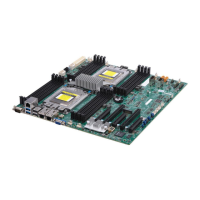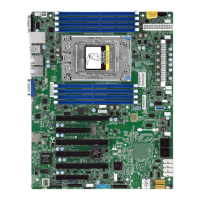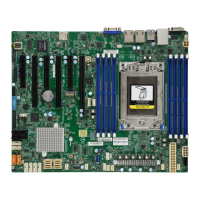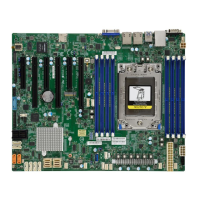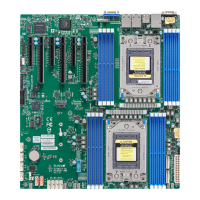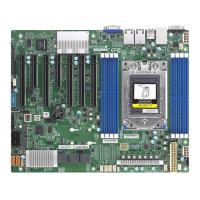Do you have a question about the Supermicro H11DSi and is the answer not in the manual?
Provides an overview of key board features, jumpers, and connectors for quick system setup.
Details the specifications and capabilities of the H11DSi / H11DSi-NT motherboard.
Explains the CPU architecture and chipset supporting the motherboard's functionality.
Describes features for monitoring system voltage, temperature, and fan status.
Explains the Advanced Configuration and Power Interface for power management.
Details the Super I/O chip and its serial port capabilities.
Provides precautions for handling static-sensitive components to prevent damage.
Guides on securely mounting the motherboard into the chassis using standoffs and screws.
Step-by-step instructions for installing CPUs and heatsinks onto the motherboard.
Covers supported memory types, population guides, and installation procedures.
Identifies and describes the rear panel connectors and their functions.
Details the header pins for front chassis buttons and indicators.
Explains various board connectors like power, fan, and DOM power.
Describes jumper functions for modifying motherboard operations.
Explains the status indicated by onboard LEDs for system monitoring.
Offers systematic steps to diagnose and resolve common system issues before or after power-on.
Outlines steps for obtaining technical assistance and information needed for support.
Provides answers to common queries regarding memory support and BIOS updates.
Details the process for returning products for warranty service and RMA procedures.
Provides instructions for safely removing and installing the onboard CMOS battery.
Introduces the AMIBIOS Setup utility for the H11DSi / H11DSi-NT motherboard.
Describes the initial BIOS screen and system information display.
Covers detailed system configurations for boot features, PSP, ACPI, CPU, NB, and memory.
Explains settings for configuring the Intelligent Platform Management Interface.
Details how to configure and view SMBIOS event logs for system monitoring.
Covers password settings and secure boot options for system protection.
Explains boot mode selection and boot order priorities for system startup.
Describes options for saving changes, discarding them, or restoring defaults.
Introduces the AMIBIOS Setup utility for the H11DSi / H11DSi-NT motherboard.
Describes the initial BIOS screen and system information display.
Covers detailed system configurations for boot features, PSP, ACPI, CPU, NB, and memory.
Explains settings for configuring the Intelligent Platform Management Interface.
Details how to configure and view SMBIOS event logs for system monitoring.
Covers password settings and secure boot options for system protection.
Explains boot mode selection and boot order priorities for system startup.
Describes options for saving changes, discarding them, or restoring defaults.
Guides on downloading and installing system drivers and utilities from FTP and website.
Introduces the SuperDoctor 5 hardware monitoring program and its features.
Warns about the danger of explosion if batteries are replaced incorrectly.
Advises on proper disposal of the product according to national laws and regulations.
Explains the Unified Extensible Firmware Interface (UEFI) and its role in system bootup.
Describes the UEFI BIOS flash chip structure and recovery block function.
Provides instructions on recovering the BIOS using a USB-attached device if the system fails to boot.
| ECC | Yes |
|---|---|
| Memory voltage | 1.2 V |
| Memory slots type | DIMM |
| Number of memory slots | 12 |
| Supported memory types | DDR4-SDRAM |
| Maximum internal memory | 2000 GB |
| Supported memory clock speeds | 2666 MHz |
| Component for | PC |
| Motherboard chipset | System on Chip |
| Motherboard form factor | Extended ATX |
| Motherboard chipset family | AMD |
| PS/2 ports quantity | 0 |
| USB 2.0 ports quantity | USB 2.0 ports have a data transmission speed of 480 Mbps, and are backwards compatible with USB 1.1 ports. You can connect all kinds of peripheral devices to them. |
| USB 3.2 Gen 1 (3.1 Gen 1) Type-A ports quantity | 2 |
| Number of SATA III connectors | 10 |
| Number of DIMM slots | 16 |
| Supported RDIMM module capacity | 8GB, 16GB, 32GB, 64GB |
| BIOS type | AMI |
| ACPI version | 5.1 |
| BIOS memory size | 128 Mbit |
| On-board graphics card model | Aspeed AST2500 |
| Storage temperature (T-T) | -40 - 70 °C |
| Operating temperature (T-T) | 10 - 35 °C |
| Storage relative humidity (H-H) | 5 - 95 % |
| Operating relative humidity (H-H) | 8 - 90 % |
| Wi-Fi | No |
| Ethernet interface type | Gigabit Ethernet |
| PCI Express x8 (Gen 3.x) slots | 3 |
| Processor socket | Socket SP3 |
| Supported storage drive interfaces | SATA III |
| Depth | 331 mm |
|---|---|
| Width | 305 mm |

